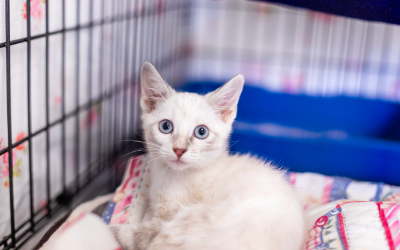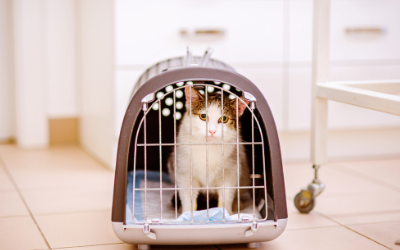Life Skills for Pets: Crate Training and Confinement for Kittens and Cats
Is crate training really something to do with kittens and cats?
Yes! Crate training is most commonly used with dogs, but it can be useful for kittens and cats too.
Why would I want to crate train my kitten or cat?
Contentment during confinement is an important life skill for pets.
Examples of situations when being content in a crate is useful for kittens and cats:
- A safe place when home alone or unsupervised which prevents housetraining mistakes, property damage, and eating dangerous items. It also keeps pets separate from visiting workers, guests, etc. if needed.
- A safe place to sleep undisturbed.
- Travel by car or airplane.
- Medical care and visits to the veterinarian.
- Grooming visits.
- Boarding or vacation camp.
- A way to rest and relax for a nap or break time.
- Emergencies such as evacuations or temporary sheltering.
A crate for a pet is like a crib, travel sleeper, or a playpen for a small child. It is a safe area, often associated with resting and sleeping. Crating and confinement training are not cruel and when done properly most pets derive comfort and security from their crate. Often the crate and bed can be brought along during travel, allowing the pet to have a "home away from home."
When should I start crate training?
Crate training can start at any age. Starting early usually makes training easier. The vast majority of pets can and should be trained, but a small number may experience true distress when confined. If you try the training suggestions here and your pet shows distress such as prolonged vocalization, eliminating outside the litterbox that you have provided in the crate, trying to escape, salivation, rapid continuous movement, or you are concerned, consult your veterinarian before continuing with your training plan.
Your cat needs daily social interaction and physical and mental exercise to remain healthy. Crating or planned confinement to an exercise pen with a lid, a pet-proofed room, or similar small area is an excellent management tool for times when your cat cannot be supervised or needs a quiet rest period. Make sure your cat is receiving plenty of healthy exercise and interaction. Extended periods of confinement are not healthy for animals. Confinement is not intended to be continuous or represent the majority of a cat’s time budget.
How do I choose a crate for my cat?
Different crates have pros and cons.
Wire Crates:
- easy to move, fold flat for storage
- easy to see the pet inside
- least secure: pets may damage the crate if escape is attempted
Plastic Crates:
- medium weight
- easy to clean, contains messes
- provides a quiet area with less visual stimulation
Metal Box Style Crates:
- sturdy and durable for any kind of travel
- heavy and require additional storage area
- highest cost to purchase
Crate Alternatives:
- 'exercise pens' are folding expandable pens, often with a ceiling
- cat proofed room with a sleeping area, scratching area, water station and litter
If the crate is used for sleeping or confinement, the crate should be large enough for the cat to comfortably lay on her side stretched out, and also have room for a small litterbox. For travel, the crate should be large enough for the cat to comfortably stand, stretch, and turn around but no larger.
For travel, smaller crates are better because if the crate is jostled, such as a rapid braking maneuver in a vehicle, there is less risk of the animal being thrown inside the crate and injured. Larger crates are often chosen for confinement in the home.
How do I train my cat to use its crate?
Positive reinforcement training is the best way to help pets learn about confinement. Before a training session, make sure your cat has had:
- enough exercise
- an opportunity to eliminate; using a litterbox in the crate may take some getting used to
Keep the crate in a quiet part of the main living area of the house. Keeping the crate near a feeding station or scratching station is a good way to prevent fear of the crate in the future.
Make the crate a place for quiet enjoyment. Think of ways to encourage happy, still behavior. Ideas for how to do this include:
- feed your cat’s meals inside the crate.
- when offering edible chews, food-stuffed toys, etc. offer them in the crate.
At first, leave the crate door open when providing these happy quiet experiences. Gradually, begin closing the door and walking away. For example, open the door, place the food toy inside. When the kitten or cat goes into the crate, close the door and walk away while the cat is chewing or playing with the food toy. Often when they are done playing they will rest.
"At first, leave the crate door open when providing these happy quiet experiences."
For older animals if the crate is new, you may need to begin by doing these exercises beside the crate rather than inside it. Then gradually over a period of a few days or a few weeks, moving closer and closer to the crate for quiet fun time and sleep time.
It is normal for some cats to vocalize briefly, try to open the crate door, or act fidgety when confined, especially when confinement is new. Observe from a distance. If the behavior lasts a short time and does not include the distress signs (prolonged vocalization, eliminating outside the litterbox that you have provided in the crate, trying to escape, salivation, rapid continuous movement), try waiting a short time and see if the cat will settle. Letting a cat out when they are meowing or scratching will teach the cat that you will open the door when they meow or scratch. This can create problems because the animal learns to ask for attention rather than learning to settle on its own. However, if signs of significant distress are present, you will need a new plan. If you are not sure, make a short video of the behavior and share it with your veterinarian to help you determine if you should wait it out, or if your pet is experiencing true distress and training should be discontinued.
Can I train my cat to get into the crate on cue?
Once your cat is willingly going into the crate, it is time to introduce a cue to ask them to go into the area. Set up a few training sessions each day and repeat the procedure anytime you will be placing your pet in the crate.
- Pick up a few pieces of kibble or small training treats.
- Say the cue, such as "Kennel" or "House," walk to the crate and wait by the door.
- Toss a treat inside for your cat to follow so they will walk into the crate.
- Once the cat goes inside, use a word such as "Yes!" or "Good!" and drop 2-3 more treats into the crate while you close the door.
- Once your cat is quickly running into the crate when you say the cue, begin fading step 3 and skip to step 4 to reward the crate behavior.
Practice from greater and greater distances until your cat will happily run to their crate from anywhere in the home.






